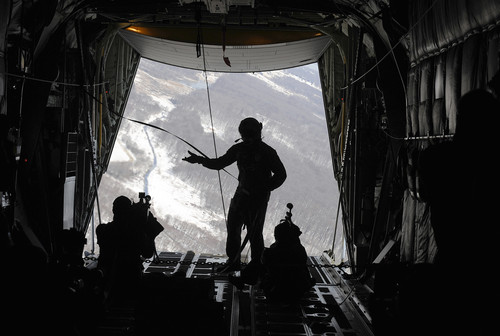Air-Based Logistics in Afghanistan
BY Herschel SmithTech Sgt. Matt Wright, a C-130 loadmaster, catches what is left of a parachute after a load was dropped from their plane over Aberdeen during a training mission at Warfield Air National Guard base.
We have focused on logistical supply routes to Afghanistan, from India over Kashmir to Kabul (by air) and through Georgia and Azerbaijan to Turkmenistan over land and the Caspian Sea. Friend of The Captain’s Journal David Wood of the Baltimore Sun has an article on logistics within Afghanistan.
Maryland Air National Guard cargo crews are prepping for an expected deployment to Afghanistan next year, flying a critical mission of air-dropping supplies to U.S. troops fighting in remote locations.
Delivering ammunition, rations and water by parachute from the Guard’s C-130J cargo planes is increasingly necessary in Afghanistan, not just because troops are being scattered to small, local bases as part of a new strategy, but also because of the growing danger that ground convoys will be attacked by Taliban insurgents, senior U.S. officers said. The more cargo that goes by air, the less risk to soldiers on convoys.
“We’re saving soldiers’ lives,” said Lt. Col. Mike Mentges, a Maryland Air National Guard pilot who flew missions there last year.
To make drops from altitudes ranging from 700 to 25,000 feet, a C-130 lowers its rear ramp, pitches its nose up sharply and unleashes up to a ton of cargo packed in pallets that float down under parachute canopies.
Under extreme conditions such as bad weather or a firefight raging in the drop zone, the Guard can rig a pallet with a satellite location receiver and a steerable parachute, and the cargo will maneuver itself to precise coordinates as much as 10 miles away …
American commanders are trying to avoid the fate of Russia’s Red Army, which was defeated in 10 years of combat in Afghanistan in part because it couldn’t easily resupply its ground forces. Struggling to force their way through insurgent ambushes, improvised explosive devices and land mines, the Russians lost 11,389 trucks, 2,452 armored personnel carriers and command vehicles, and 147 tanks, according to a 1995 U.S. Army study.
The Marines have a fairly audacious plan to use UAVs to resupply their troops.
By this summer, combat troops in Afghanistan could be getting re-supplied by giant unmanned aerial vehicles, a Marine Corps general told Congress Wednesday.
The Marines are working with industry to build a cargo-carrying UAV capable of hauling up to 1,200 pounds of battlefield essentials — such as ammunition, water and batteries — to ground troops in remote places, Assistant Commandant of the Marine Corps Gen. John Amos told the House Appropriations Committee’s subcommittee on defense.
The move is part of a short-term plan to find new ways to reduce the weight Marines carry into combat. Details are sketchy, but Amos said “I’m looking for something now. We want to get a solution into Afghanistan by this summer.”
This kind of out-of-the-box thinking is valuable because logistics is so much more difficult than it was in Iraq. But sooner or later, the roads must be controlled, the physical terrain must be won, and the population must be secured. This kind of air supply must be considered to be a temporary measure to be replaced upon increased force projection and success in counterinsurgency. Two years from now if we are still relying on air logistics to the same extent in Afghanistan, the campaign will have been lost.
The Captain’s Journal is proud to be the most up-to-date and comprehensive clearinghouse for current information and analysis on military logistics anywhere.






No comments yet.
RSS feed for comments on this post. TrackBack URL
Leave a comment